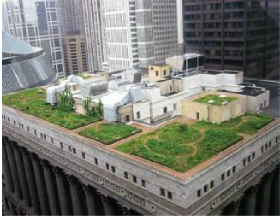The heat island effect can be counteracted in several ways:
♤ Most prominent is to use light color or white or reflective materials in construction work – roof top, houses, road, and pavements – to increase the albedo. Dark/Black surfaces can be up to 21°C hotter than light surfaces and that excess heat is transferred to the building itself, creating an increased need for cooling. By switching to light colored roofs, buildings can use 40% less energy.
♤ Mitigation of the UHI effect can be accomplished through the use of green roofs (figure 9). The roof of a building is partially or completely covered with vegetation and a growing medium, planted over a waterproofing membrane. Rooftop ponds are another form of green roofs which are used to treat grey-water. Apart from mitigating the UHI effect, Green roofs serve several purposes for a building, such as absorbing rainwater, providing insulation, creating a habitat for wildlife, and helping to lower urban air temperatures. Financially, it reduces energy usage, bring tax incentives provided by the government, increases life span of roof etc.

